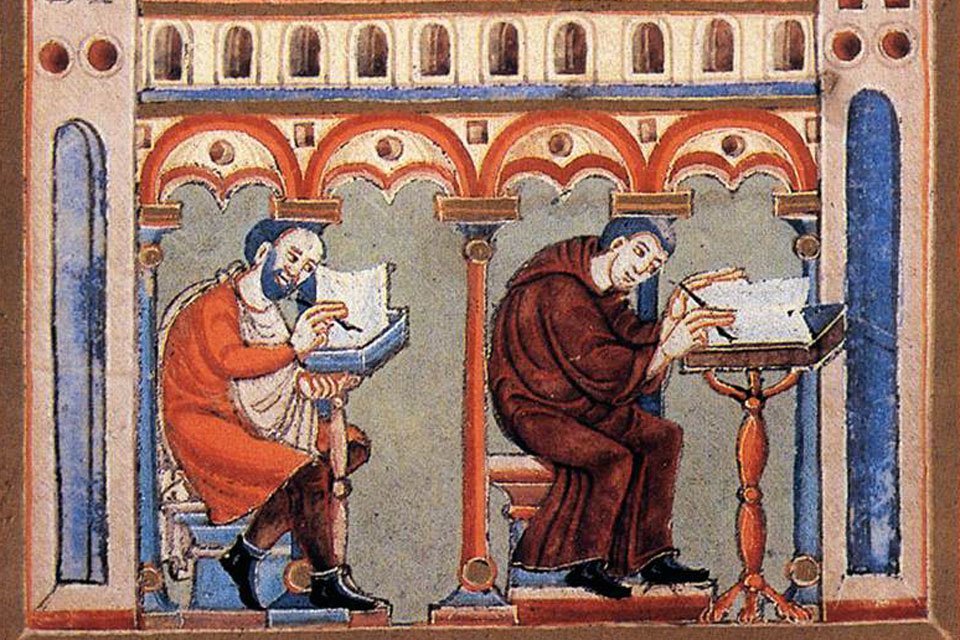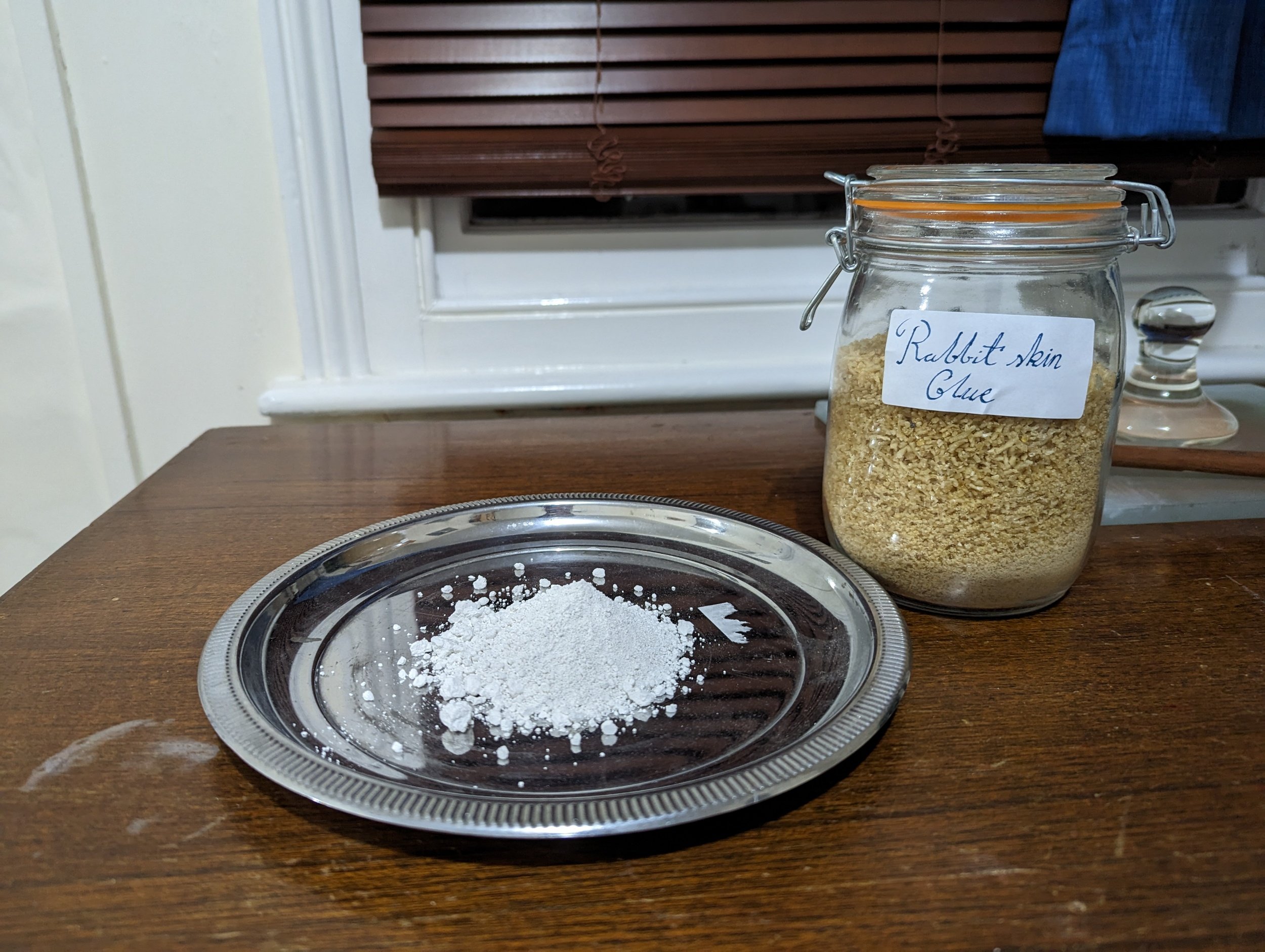What is vermilion?
Grinding vermilion pigment into oil paint.
Vermilion is a beautiful, vibrant red pigment that is synonymous with the riches of Medieval and Renaissance art. Think of Van Eyck’s Lucca Madonna, Titian’s ‘Assumption of the Virgin’, or Raphael’s ‘Small Cowper Madonna’. Despite its richness, it is but a simple chemical compound containing only two elements - mercury and sulfur (mercury sulfide HgS). Its chemical structure is shown in the “ball and stick” image below. It occurs naturally in nature as a rock called cinnabar, which itself has been used as a pigment since antiquity. The natural cinnabar typically has a slightly earthier hue, since it contains brown earth-based impurities, but the synthetic vermilion is a strikingly brilliant red.
The pigment is seldom used today, partially due to the fact that it can darken with time if exposed to too much light or ambient air, but mostly due to the fact that it is pretty toxic due to the mercury content. In earlier times mysticism was far more prominent in culture than it is today. The behaviour and colour of a material was believed to be far more intimately linked to its inward character than we now believe. Vermilion was no exception. This was exacerbated by the fact that its constituents mercury and sulphur too were imbibed with special properties. For example, the 8th century Arabic alchemist Jabir ibn Hayyan wrote that sulfur and vermilion were the most elementary constituents of all metals. That is all metals, including importantly for alchemists gold, are formed by their combination. (We now of course know this not to be the case). There are writings also describing the possible creation of the tincture (the philosopher’s stone) that are intimately linked to vermilion. Some believed vermilion itself to be the tincture, whereas others thought it formed the starting basis from which to create it. The holy grail of early alchemy - the transmutation of cheap metals into gold - was believed to be possible by bringing the mixture of mercury and sulphur into “perfect harmony” with one another [1]. Therefore, not only was this pigment prized for its brilliant colour - it was also prized for its transcendency and connection to the mystical realm.
How is vermilion made?
There are three main ways that vermilion has been produced over the ages.
An alchemist workshop. The manufacturing of pigments such as vermilion used to be undertaken in workshops such as these. Many alchemists were pursuing and studying the transmutation of materials from one into another. Since colour was believed to be an important character of each material, the production of valuable pigments was a good by-product and would be sold either directly to artists or through apothecaries.
The dry process
The first method of production was through the so-called dry process. Records outlining instructions for this could exist from as early as 300 AD, China. This involved simply adding the two components, sulphur and mercury together in a closed vessel and heating until it forms one uniform lump. There are reports of this being done by burying the vessel in red hot coals. This method usually produced one solid piece of vermilion which then needed to be ground down to form a pigment.
Indeed, Cennino Cennini (Italian 14th century painter and author of ‘Il Libro dell'Arte’ [2]) advises artists to purchase vermilion as a single lump and then to grind it themselves. Why? To produce a more beautiful, hand-ground pigment? No - to prevent artists being ripped off by unscrupulous alchemists who were prone to dilute the red powder down with brick dust or red lead!
The Dutch process
The dry process was refined in the later middle ages in Holland - which went on to become the epicenter of vermilion production in Europe by the late 16th century. It involved combining mercury and sulphur to produce a black powder after heating. (The black colour here is due to being in a slightly different crystal structure to the desired red form). The black powder could then be heated further, using even higher temperatures and pulverised to produce the bright red final pigment. This technique however was expensive.
The wet process
Finally, a cheaper alternative was found by German chemist Gottfried Schulz who found that the ethiops mineral (the black form of vermilion mentioned above) could be converted into the red form by heating it with ammonium. This process was less expensive and quicker than the Dutch process and became the go-to method of production. A subtle difference in hue is observed between the products of these two methods - the vermilion produced via the dry processes has a subtly cool-leaning blue hue, which you can still sometimes see in early medieval manuscripts and paintings. Whereas the vermilion from the wet process has a more fiery orange-leaning hue.
Outside the use of the synthetic vermilion, one can of course also use the raw material cinnabar by grinding the rock down into a powder - as was done for many centuries into antiquity.
Contemporary use
Vermilion is used in modern oil painting very rarely indeed. In fact, I currently know of only one place where the genuine stuff can be bought in a paint tube, and only a small collection of places that manufacture and sell the raw pigment. It has been replaced by a myriad of alternatives for an opaque, vibrant red. The most common is cadmium red - of which the hue can be varied by manufacturers. Some even produce products such as “vermilion extra” or “vermilion hue” which use a number of techniques to try and replicate the colour of vermilion with modern materials. Genuine vermilion on the other hand is almost exclusively confined to conservation and restoration work rather than in new paintings.
However, if you want to see this beautiful historic pigment in full use today then check out my post on a still life painting, in which I use the techniques employed my Jan van Eyck to exemplify how stunning these old colours can still be:
A study in scarlet - painting with vermilion
You may also like:
References
[1] Albertus Magnus, Book of Minerals, Clarendon Press, Oxford, 1967, VI, i, 2, pp. 207-208[2] You can find a full translation of Il Libro dell’Arte here. The section relating to vermilion is chapter XL.
Comments or questions?
Please do leave them in the comments box below!






